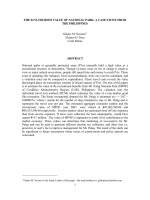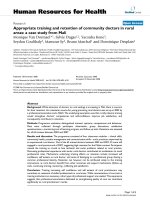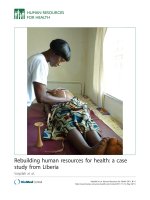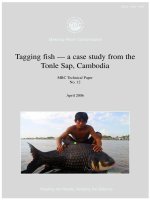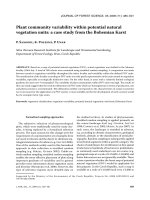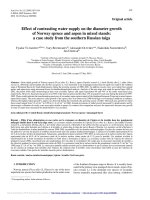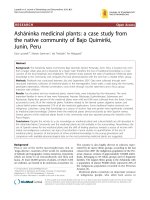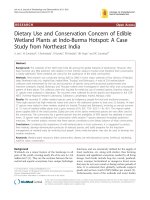market internalization a case study from hoanglong seafood corporation
Bạn đang xem bản rút gọn của tài liệu. Xem và tải ngay bản đầy đủ của tài liệu tại đây (534.15 KB, 32 trang )
<span class="text_page_counter">Trang 1</span><div class="page_container" data-page="1">
<b>UNIVERSITY OF NICE – SOPHIA ANTIPOLIS </b>
IAE School of Business Administration
<b>THANG LONG UNIVERSITY </b>
Student: Nguyen Quoc Trung (AMI9)
Supervisor: Associate Professor Doctor Le Thai Phong
</div><span class="text_page_counter">Trang 2</span><div class="page_container" data-page="2"><i><b>ACKNOWLEDGEMENT </b></i>
<i>Thank you to the Management and Employees of Hoang Long Group of companies for granting me a full access right to company’s database, reports and even site survey to study seafood business and 3F model. Interviews with Mr. Chairman and discussions with HLG management are so useful for developing the key context. </i>
<i>I especially express my gratitude to Associate Professor Dr. Le Thai Phong, who has extended his kindest suggestions and reviews during my internship’s report preparation. Without having his coach, I don’t think I can meet the deadline of submission. </i>
<i>Last but not least, it was a nice experience for me participating this M.A course. I am grateful to all Professors, TLU administration and AMI 9A classmates who have lectured, supported in the past few years. </i>
<i>I hereby declare that the thesis is my own study and complies with Nice Sophia Antipolis University’s regulations on plagiarism. </i>
</div><span class="text_page_counter">Trang 3</span><div class="page_container" data-page="3"><b>iii | </b>P a g e
<b>ABSTRACT </b>
Market selection and Market enter are key factors in preparing business plan for any company. These factors become more critical to the success of a firm who extends their operation to international markets as external factors changes fundamentally.
Vietnam agriculture and aquarium products gradually gain reputation in the world market thanks to its advantage of good quality, naturally fresh and competitive price. The government of Vietnam also signed several bilingual trade agreements and free trade agreement to encourage and/or protect Vietnamese agriculture firms entering to the word. Given that fact, Vietnamese aquarium, agriculture products faced difficulty when going internationally as tariff and non-tax barriers created by the government of imported countries to protect their homeland production and farmers.
This internship report studies the case of exporting Basa catfish from a Vietnam to the world in Hoang Long Group Corporation: why the company got blocked from its main targeted market; what was wrong with its initial Market selection and entry; how are their current markets are evaluated under theory of International Business Planning and what the recommendations made to the company management to avoid or mitigate potential risks. PESTEL model and some recommended research methodologies of authors Carpenter, M.A., and Abrams R., are used in this report.
</div><span class="text_page_counter">Trang 4</span><div class="page_container" data-page="4">
Table of Contents
INTRODUCTION ... 1
CHAPTER 1: COMPANY BACKGROUND ... 3
1.1- Company background ... 3
1.2- Expanding to seafood business... 4
1.3- Company’s products and market overview ... 5
1.4- Financial figures in 2017, 2018 and 1<sup>st</sup> half of 2019 ... 7
4.2- HLG business plan reviewed ... 16
4.2.1- HLG key exporting markets ... 16
4.2.2- Markets selected analyzing using Pestel model ... 18
4.2.3- Markets selected analyzing using Rhonda Abrams’s research recommendation ... 19
</div><span class="text_page_counter">Trang 5</span><div class="page_container" data-page="5"><b>1 | </b>P a g e
<b>INTRODUCTION </b>
<i>Vietnam long term development strategy for 2016-2020 period is: to make Viet Nam </i>
<i>basically become a modern-oriented industrialized country. However having at least 40% </i>
labor force working in rural and agricultural sector, Vietnam has to concentrate on agricultural restructuring, improving the efficiency of agricultural production in line with improving farmers’ lives. Step by step Vietnam needs to improve competitiveness of agricultural products and commodities. Re-organize production, rapidly develop value chain management and manufacturing models agriculture and aquarium products, link production with consumer markets are the country’s top priority.
Among the so-called “billion US Dollar exported value” agriculture products, Vietnam’s basa catfish recorded a turnover of 2.26 billon US Dollars in 2018 in which China and the U.S markets account more than 1 billion US Dollars. Thanks to its unique geographical conditions, Vietnam can supply the world market its famous, tasty and high nutrition frozen fillet basa catfish at the very competitive price which farmers from other countries like Indonesia, Bangladesh and even Arizona state of America cannot bid. Given Vietnam has joined World Trade Organization, signed several Free Trade Agreements (FTA) with other counterparts, agriculture products of Vietnam facing several restrictions, both tariff and non-tariff technical barriers when entering into oversea markets.
Hoang Long Seafood Corporation (HLG), a company located in Mekong delta, south of Vietnam who provides farm, feed and food for annually of 20,000 ton of frozen basa catfish ( about 3% total country export volumes) facing extremely difficult when the US government suddenly imposed anti-dumping price tariff for their products sold to the America; Brazil stopped importing basa catfish from Vietnam due to quality related concerns while domestic market is too small as Vietnamese consumers prefer fresh to frozen fish. The main targeted markets declined and even closed while the company’s financial leverage heavily depends on
<b>bank’s loan causing. As consequence, the company had to revise its original business plan, in particularly of finding new market selection and market entry. Financial result has been </b>
improved progress in past few years but the obstacles inured from ad hock business plan changed still negatively affect to the operation of company.
This internship report is made with simple rationale: were there something wrong with HLG’s market selection and market entry when going international its frozen basa catfish? The objective of the report is identifying factors, analyzing its impact level at the step of market selection and market entry when preparing an international business plan and
</div><span class="text_page_counter">Trang 6</span><div class="page_container" data-page="6">recommending a better approach to the management of HLG. As the time of internship quite short then the scope of study is just concentrating in four key markets of EU, US, Brazil and China.
The research methodology for the report was a qualitative research of:
- understanding overall Vietnam basa catfish industry and the business fluctuation past 10 years;
- collecting HLG sales, export data; analyzing company’s business reviews; interviewing and discussing with company’s key management to absorb their lesson learnt and future prospect; - analyzing the facts collected in view of International Business Plan theory for market selection and market entry and identifying the gaps (if any).
</div><span class="text_page_counter">Trang 7</span><div class="page_container" data-page="7">
After joining WTO in December 2006, Vietnam import - exports activities were booming and competition in tobacco market became tougher from both international giant firms like B.A.T, Phillip Moris who got license to do OEM and marketing activities in Vietnam as well as cross border tobacco smugglers. Vinataba, the largest Vietnam cigarettes producer also launched a wide range of products with some low-cost brands like Thang Long, White Horse, Saigon, Bong Sen, Bastion… so almost domestic cigarette producers in Mekong delta had to close their factories. Vinataba imported directly tobacco and tobacco flavor from international suppliers then HLG’s main business was seriously impacted and declined from 4<sup>th</sup> quarter of 2007.
In February 2007 HLG restructured from a limited liability company to be a joint-stock company with the equity of 266 billion VND and expanded its activities to construction,
</div><span class="text_page_counter">Trang 8</span><div class="page_container" data-page="8">infrastructure investment. The fiscal year of 2007 was a milestone in HLG history with turnover of 875 billion VND, and earned the highest ever profit after tax of 117 billion VND.
<b>1.2- Expanding to seafood business </b>
In August 2008, HLG went IPO and decided to move its core business to seafood industry, targeted to basa catfish product. The company had invested huge capitals and applied 3F model in this new business of feed, farm and food process in Dong Thap province where they were given Corporate income tax incentive and land usage right at very reasonable annual rental.
Basa catfish (Pangasius) is a kind of native river fish which can be farmed with highest productivity only in Mekong delta, Vietnam thanks to its unique geographic condition. Being natural freshwater fish, it used to be caught by fishermen with limited quantity and the volumes highly fluctuated depending on the seasons. Having tasty meat, it has been a favorite choice of seafood dishes for Mekong delta residents. Some Vietnamese seafood processing firms did export frozen basa catfish fillet to Australia in 1988 as testing cases and got positive feedback from oversea consumers. Since natural basa catfish was not able to meet the demand of industrial size of operation then some farmers tried to have basa catfish farmed by feeding on river’s floating house and digesting ponds along Mekong river’s branches and got success in An Giang, Dong Thap, Tien Giang. (Nguyen 2019) basa catfish harvested by the farmers in Mekong delta then was able to satisfy demand in big volume of seafood processing plants and the name of basa became popular in not only Australia but Euro, and the US since the years of 1990s. In September 2009, HLG listed all 44,337,585 shares (10,000 VND/share par value) in Hochiminh city Stock Exchange (HoSE), Vietnam.
In June 2010, just less than 3 years from the time of selecting seafood as core business, the company has inaugurated a sophisticated complex facility of:
i) 48 hectare fishery ponds,
ii) An aquarium food processing plant with production capability of 150,000 tons/year (Mekong aquarium food plant)
iii) a fresh fisher processing plant of 130 ton/day with frozen storage facility of 5,000 tons (Hoang Long seafood processing plant)
in Tam Nong district, Dong Thap province. (Hoang Long 2017) at the time of completion, this 620 billion VND investment was among the largest and most advanced technology fishery-related-facility in Mekong delta of Vietnam.
</div><span class="text_page_counter">Trang 9</span><div class="page_container" data-page="9"><b>5 | </b>P a g e
<b>1.3- Company’s products and market overview </b>
From June 2010 upto now, HLG’s main products are: fresh basa catfish, aquarium food brands Hoang Long and frozen basa catfish fillet (almost no brand, packed following buyers’ instruction)
With fresh basa catfish harvested from its own 48 hectare fishery ponds, they were material for the Hoang Long seafood processing plant. (Mai 2018) in fact HLG has to procure more fresh basa catfish from market for the fresh fishery processing plant as the harvested output 48 hectare ponds just meet 60% demand (a hectare fishery pond can deliver 500-600 ton fresh basa catfish/annum). With Hoang Long aquarium food, HLG uses just a part of its output products for the 48 hectare fishery pond’s consumption. (Chi 2017) it’s statistic that 1kg of matured basa catfish needs 1.5 kg -1.7 kg of aquarium food. Assuming HLG can harvest 25,000 ton of raw-material basa catfish from its owned 48 hectare ponds then demand for aquarium food would not beyond 45,000 ton per year; the rest of 100,000 ton aquarium food should go to the market and the buyers are farmers in Mekong delta who also farm basa catfish. In order to secure the supply’s source of fresh basa catfish to Hoang Long seafood processing plant, HLG also supplied aquarium food to some selected farmers under food-fresh basa catfish exchange method: HLG supplied aquarium food to farmer without payment requested and farmer signed a commitment of offsetting the debt by selling matured fresh basa catfish to HLG when having harvested.
raw-With frozen basa catfish fillet, nearly 100% of the finished products were exported as Mekong delta is in rich of fresh fish and local consumers prefer fresh fish to frozen fillet fish. Below are some statistics of Vietnam’s basa catfish export and HLG frozen basa catfish fillet sales/export during 2010 – 2018 period.
<b>Table 1.3.1: Vietnam basa catfish harvested quantity, export volumes and average FOB price </b>
</div><span class="text_page_counter">Trang 10</span><div class="page_container" data-page="10">Harvested volume Left direction: Volume in tons
<i> ( Source: VASEP 2018 report ) </i>
<b>Table 1.3.1: HLG basa catfish export statistics for 2015-2018 period. Year Sales volume </b>
<b>(ton) </b>
<b>Exported volume (ton) </b>
<b>Turnover Export turnover (US Dollars) </b>
<i> (Source: company exporting report) </i>
<b>Table 1.3.2: HLG basa catfish export volume statistic for 2015-2018 by countries imported </b>
<i>Unit measure: ton </i>
<b>Year EU Brazil Mexico US China Asia(non China) </b>
<b>Middle East </b>
</div><span class="text_page_counter">Trang 11</span><div class="page_container" data-page="11"><b>7 | </b>P a g e
<b>Table 1.3.2: HLG basa catfish export turnover statistic for 2015-2018 by countries imported </b>
<i>Unit measure: 1,000 US$ </i>
<b>Year EU Brazil Mexico US China Asia (non China) </b>
<b>Middle East </b>
<i> (Source: company exporting report) </i>
HLG appointed CEO, Deputy CEO in 2015, the new management team setup their owned created reporting structure then export data from 2014 backward was not available.
HLG was unable to export its basa catfish to the US under the name of company during 2015-2019, except a very small order of 16 ton in 2017 as consequence of Farm bill for Vietnam basa catfish products and the company failed to prove that they were not subsidized by the government. As long as HLG listed in the anti-dumping price tariff Vietnam basa catfish firm, the is no way for the company to directly export its product to the US.
EU, Brazil, Mexico and China imported more than 70% company’s sales volume during this period. China just arose as the 2<sup>nd</sup> largest market after EU in last 2 years however all exports to China was done via cross border trade export. Export to Brazil decreased in 2015 as they stopped importing basa catfish from Vietnam due to quality related controls, resumed in 2016 and reached the highest position in 2017 but suddenly downed in 2018 for the same reason: hygiene quality food’s concerns.
EU market export volumes did not fluctuate largely past 4 years. All exports to the EU made under official distribution contracts with oversea distributors.
<b>1.4- Financial figures in 2017, 2018 and 1<small>st</small> half of 2019 </b>
I. Cash and cash equivalent 110 9,882,292,099 22,446,509,654 12,021,071,034
</div><span class="text_page_counter">Trang 12</span><div class="page_container" data-page="12">investments
III. Short term Accounts
receivable <sup>130 </sup> <sup>915,137,905,131 </sup> <sup>916,777,773,644 </sup> <sup>642,127,662,768 </sup>
IV. Finished products 140 244,445,703,980 249,052,010,464 133,715,168,957 V. Other short term assets 150 30,782,450,960 28,782,465,094 26,775,106,691
II. Fixed assets 220 385,348,111,842 396,374,735,266 409,854,629,488
IV. In-progress construction fixed
<i> (Source: company financial reports) </i>
HLG working capitals are fully financed by the bank short term loans. Since the company operation result generated serious lost past years so shareholder equity even in negative figure since 2015. Chairman of HLG, Mr. Pham Phuoc Toai made strong commitment to the normal operation of HLG by mortgaged his own properties to the bank for the bank loan’s guarantee so there is no concern with the continued operation capability of the company. All loans are mortgaged loans computed in US Dollars as the interest rate for loan made in US Dollars are much cheaper than VND (interest rate of 4.5% short term loan in USD while
</div><span class="text_page_counter">Trang 14</span><div class="page_container" data-page="14"><i> (Source: company financial reports) </i>
Turnover increased substantially in 2018 (37% increased to 2017 figure) and even better in 1<sup>st</sup>half of 2019 (18% higher than 2018). Gross margin improved tremendously to 12.7% (for 1<sup>st</sup>half 2019), 10.6% (for fiscal year 2018) and 4.4% (for fiscal year 2017) thanks to reducing unit cost of goods sold coming from:
- Efficiency of fresh fish processed progress at the plant; - Maximizing operation scale.
Financial expenses also under well-controlled as the company targeted to customers who accepts FOB plant contracts, rather than D/A or L/C contracts. Thanks to surplus fresh fish supply source in the free market, HLG also did not have to pay immediately when procuring fresh fish for the plant’s production as it did before. Earning positive cashflow from main activities helping the company to reduced, at certain level, of short term loan payment and interest in last few years was relatively cheaper than years before.
Sales admin costs and overhead costs remain unchanged. In fact, the company has reviewed these costs on monthly basic even by the Chairman, all factors were optimized in line with the industry so there seems no room for further cost cutting.
</div><span class="text_page_counter">Trang 15</span><div class="page_container" data-page="15"><b>11 | </b>P a g e
<b>CHAPTER 2: COMPANY STRUCTURE AND ORGANIZATION CHART 2.1- Company structure </b>
HLG structure their operations as a group of companies in which:
i) holding company (HLG holding) centrally controls all financial and banking, human resources, purchasing, ERP & informatics technologies activities. Group’s functional departments implement everything related to such matters for both holding & subsidiaries, then allocate to each strategic business unit or cost centre. Given its registered head office in Long An province, the top corporate management leads the group’s operation from their liaison office located in Tam Nong town, Dong Thap province where the farm-feed-food facilities stationed. Even HLG is a listed company but the Chairman holds 80% issued shares than delegation of authority is not clearly setup and/or implemented. He and his daughters who is vice chairwoman of HLG review and decide nearly everything, even endorse any bank account holder signatories. The CEO Mr. Nguyen Quoc Dao who was an experienced CFO before joining HLG in 2015 - acts just as a senior financial and corporate planning advisor to the Chairman.
HLG holding and its domestic affiliates are only using PGBank for their transaction. Thanks for this “cash pooling” service, HLG’s management can utilize their cash flow at corporate level.
- domestic subsidiaries which are wholly owned by HLG holding:
ii) Hoang Long aquarium farming company: farming basa catfish, then supplying harvested fresh fish to Hoang Long seafood processing company. Since they just farm basa catfish in HLG owned ponds and using HLG supplies aquarium food then the management of this firm is simple. Except concentrating on river fish farming know-how, this subsidiary does not require nor consume much resource.
iii) Mekong aquarium food: producing food for basa catfish, supplies internally for Hoang Long aquarium farming company and sells to the market as well. Materials for producing were procured by HLG holding but invoicing directly from the suppliers to Mekong aquarium food. This company also sets up their own, independently marketing & distribution strategy but cashflow is fully controlled by the HLG holding.
Beside the operation and maintenance of a 150,000 ton/annum plant producing aquarium food, Mekong aquarium food also responsible for debt collection from selling aquarium food or exchanging aquarium food-for-fresh basa catfish with farmers who were given credit of
</div><span class="text_page_counter">Trang 16</span><div class="page_container" data-page="16">late payment. Exchanged basa catfish from farmers (if any) will be sold to Hoang Long seafood processing and written-off against the raw materials procured by HLG holding. iv) Hoang Long seafood processing: procuring fresh basa catfish from Hoang Long aquarium farming company and from the free market; processing fresh fish to be fish fillet, packaging and having it frozen in the cold storage. The company sells frozen fillet catfish to both domestic and international buyers and carries out all distributing, marketing related activities. Like Mekong aquarium food, cashflow of this subsidiary also under the strictly monitored of HLG holding.
Nearly all finished products of this company were exported. Payment terms would vary from one to other but mostly Irrevocable L/C and 100% down payments before shipping. Logistic services related to goods delivery, shipping… is fully outsourced.
v) Offshore company established in the US (HLG US holding LLC): carries out marketing, logistics and even outstanding debts collection activities for US, Brazil and Chile markets. Since HLG was charged extremely high import tariff for frozen basa catfish by the US Department of Commerce then this offshore company remains operation moderately.
<b>2.2- Organization chart: </b>
Figure 2.2.1 Company’s Organization
<i>(source: company profile) </i>
<small>Group Chairman, Chairwoman</small>
<small>Finance DeptProcurement DeptH/R DeptIT & ERP Dept</small> <sup>Hoang Long fish </sup><sub>farming</sub>
<small>Technical Dept</small>
<small>48 hectare pond</small>
<small>Mekong Aquarium food</small>
<small>Production Plant</small>
<small>Accounting dept</small>
<small>Sales Dept</small>
<small>Hoang Long seafood process</small>
<small>Fresh fish processing plant</small>
</div>
